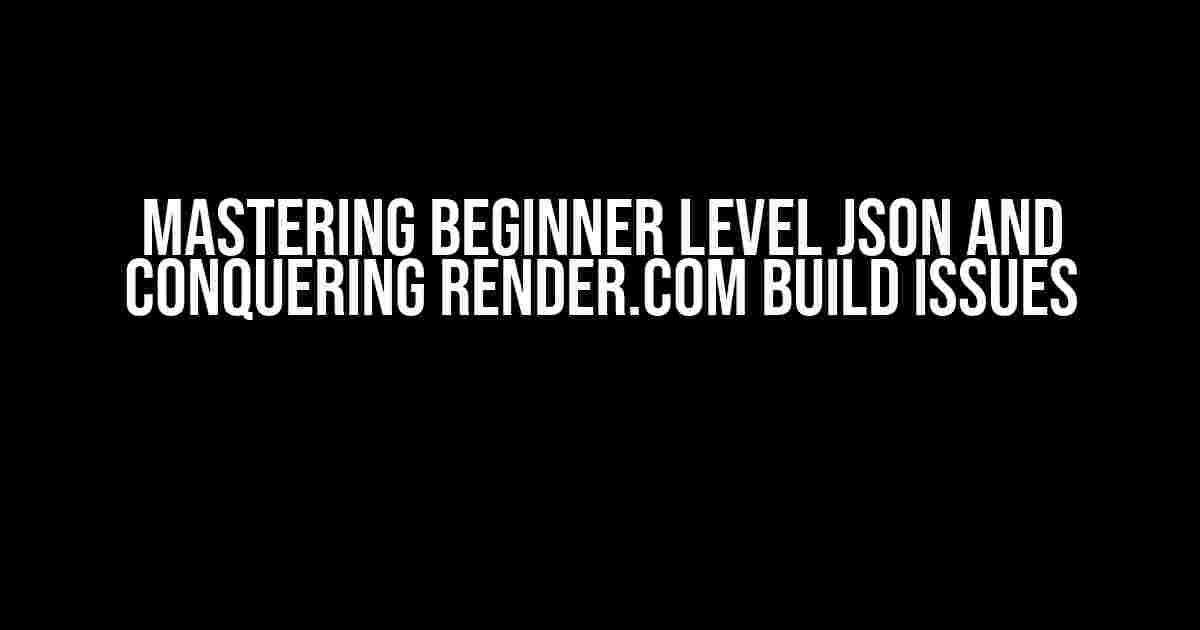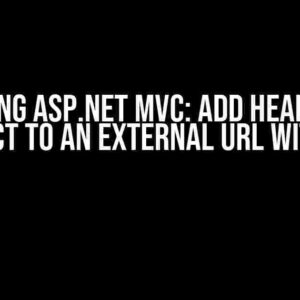Welcome to the world of JSON and Render.com! As a beginner, it’s natural to feel overwhelmed by the vast expanse of coding concepts and terminology. Fear not, dear reader, for this article is designed to guide you through the fundamental principles of JSON and help you troubleshoot common issues with Render.com builds.
What is JSON, Anyway?
JSON (JavaScript Object Notation) is a lightweight data interchange format that allows you to store and exchange data between web servers, web applications, and mobile apps. It’s a simple, human-readable format that’s easy to understand and work with.
{
"name": "John Doe",
"age": 30,
" occupation": "Developer"
}
In the example above, we have a JSON object with three key-value pairs: name, age, and occupation. This data can be easily parsed and utilized by various programming languages, including JavaScript, Python, and Ruby.
Basic JSON Syntax
JSON syntax is composed of the following elements:
{}: Curly braces denote the start and end of a JSON object.[]: Square brackets indicate an array of values.key: value: Key-value pairs are separated by a colon (:).string: Strings are enclosed in double quotes (" ").number: Numbers are represented as is.trueorfalse: Boolean values are written as is.null: Null values are represented as is.
Common JSON Data Types
JSON supports the following data types:
| Data Type | Description |
|---|---|
| String | A sequence of characters enclosed in double quotes. |
| Number | A numeric value. |
| Object | A collection of key-value pairs. |
| Array | A collection of values. |
| Boolean | A true or false value. |
| Null | A null value. |
JSON Best Practices
When working with JSON, keep the following best practices in mind:
- Use consistent naming conventions (camelCase or underscore notation).
- Avoid using spaces in property names.
- Use double quotes for string values.
- Keep your JSON data concise and organized.
Render.com Build Issues: Common Causes and Solutions
Render.com is a popular platform for building and deploying web applications. However, even the most seasoned developers encounter build issues from time to time. Here are some common causes and solutions to get you back on track:
Issue 1: JSON Syntax Errors
Syntax errors in your JSON file can cause Render.com builds to fail. To fix this issue:
- Check for missing or mismatched curly braces (
{}). - Verify that key-value pairs are separated by commas (
,). - Ensure that strings are enclosed in double quotes (
" ").
Issue 2: Version Conflicts
Outdated or conflicting package versions can lead to build issues. To resolve this issue:
- Check your
package.jsonfile for outdated dependencies. - Run
npm installoryarn installto update dependencies. - Verify that your dependencies are compatible with each other.
Issue 3: Missing Environment Variables
Failing to set environment variables can cause builds to fail. To fix this issue:
- Check your
render.yamlfile for missing environment variables. - Set environment variables using the Render.com dashboard or CLI.
- Verify that environment variables are properly referenced in your code.
Issue 4: Asset Optimization
Unoptimized assets can lead to build issues and slow page loads. To resolve this issue:
- Use a bundler like Webpack or Rollup to optimize your code.
- Enable compression for assets like images and fonts.
- Use a CDN to distribute static assets.
Conclusion
Mastering JSON and troubleshooting Render.com build issues may seem daunting at first, but with practice and patience, you’ll become a pro in no time. Remember to keep your JSON data concise and organized, and don’t hesitate to seek help when encountering build issues. By following the best practices and solutions outlined in this article, you’ll be well on your way to building fast, scalable, and reliable web applications.
Happy coding!
Frequently Asked Questions
Get your Beginner level JSON and Render.com build issues resolved with these frequently asked questions!
Q1: What is JSON and how does it help in Render.com builds?
JSON (JavaScript Object Notation) is a lightweight data interchange format that helps you store and exchange data between different systems. In Render.com, JSON files play a crucial role in defining the build configuration, dependencies, and environment variables. By correctly formatting your JSON files, you can ensure smooth builds and avoid common issues.
Q2: Why does my Render.com build fail with a JSON parsing error?
Oops, that’s frustrating! A JSON parsing error usually occurs when there’s a syntax mistake in your JSON file. Double-check for typos, misplaced brackets, or incorrect character encoding. Make sure your JSON file is properly formatted and follows the Render.com-specific requirements. If you’re still stuck, try validating your JSON file using an online tool or asking a friend for a fresh pair of eyes.
Q3: How do I troubleshoot slow or stuck builds on Render.com?
Don’t let slow builds drive you crazy! When dealing with slow or stuck builds on Render.com, try the following: (1) Check the build logs for errors or warnings, (2) Verify that your JSON file is correctly configured, (3) Ensure you’re using the latest version of your dependencies, and (4) Reach out to the Render.com support team for personalized assistance. Remember, patience is a virtue, but troubleshooting skills are a superpower!
Q4: Can I use a JSON editor or IDE to simplify my Render.com builds?
Absolutely! Using a JSON editor or IDE can be a game-changer for your Render.com builds. Tools like Visual Studio Code, IntelliJ IDEA, or JSON Editor Online can help you write, validate, and format your JSON files with ease. These editors often provide features like syntax highlighting, code completion, and real-time validation, making it easier to catch mistakes and optimize your build configurations.
Q5: What are some best practices for writing efficient JSON files for Render.com builds?
To write efficient JSON files for Render.com builds, follow these best practices: (1) Keep your JSON files concise and well-organized, (2) Use consistent naming conventions and syntax, (3) Minimize duplicate code and leverage modular configurations, (4) Validate your JSON files regularly, and (5) Test your builds frequently to catch errors early. By following these tips, you’ll be well on your way to becoming a Render.com build master!


